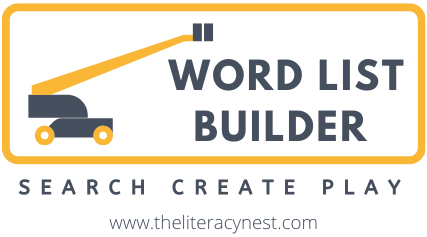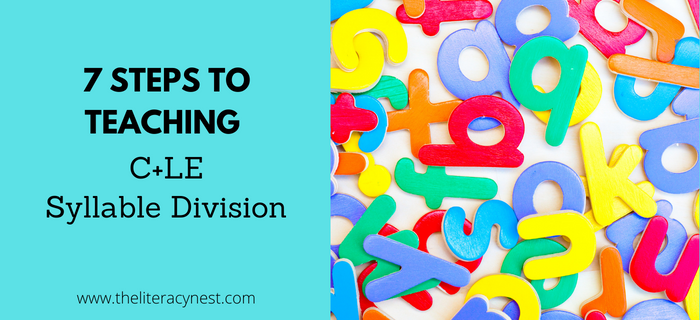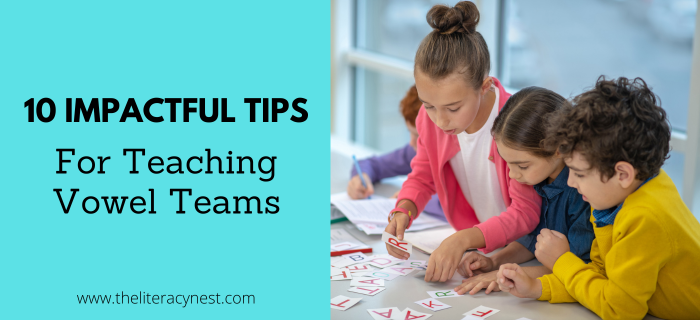Syllable Series Part Five: Open Syllables
Welcome back! This is part five in my six-part syllable series. In this part, we‘ll explore the r-controlled syllable! I am having so much fun sharing this information about syllables with you!

A few quick reminders:
- If you are new to this series: Please read part one by clicking here and part two by clicking here.
- To follow along with this series, please download a chart I created on the six syllable types by clicking here. It spells out CLOVER. Each letter in CLOVER stands for a syllable type but is NOT taught in that order.
- I am blogging in the order the syllable types should be taught, so follow along and you’ll see how I do it.
What is an open syllable?
Chant or sing this sentence with your students until they know it by heart.
“Every syllable has to have a vowel.“
An open syllable is a syllable with just one vowel. That one vowel appears at the end of a syllable. Words like baby (ba/by), raven (ra/ven), silent (si/lent), and robot (ro/bot) all have open syllables as the first syllable. Mono-syllables like she, he, go and so are also considered open syllables.
How I teach open syllables:
Backtrack to our first post in this series on closed syllables. Your students need to have a firm grasp of the closed syllable BEFORE you venture into the open. Remember why we’re teaching syllables? To help them become less haphazard about their spelling decisions and become better, more strategic readers and spellers. (decoding and encoding y’all ;))
Another reason why I’m bringing up the closed syllable is because we want to pull out the door analogy again. But this time, we’re going to model the difference between a closed and an open syllable by opening and closing the door. In a closed syllable, you have a nice little consonant after the vowel to close it in and make it short. In an open syllable, the vowel isn’t closed. It’s open, making the vowel long.
Clover Time
You’ll want to demonstrate the difference here several times and help children vocalize what a closed syllable is versus an open syllable. You may want to draw a simple Venn diagram to show similarities and differences. Most importantly, give your students TONS of practice with sorting syllables. Start with sorting between open and closed. Then… up the ante!
Remember that handy clover chart I asked you all to download? (Download here if you forgot or missed it. It’s okay.) That chart should be glued into a notebook whether it be for Orton-Gillingham or word study-related practice.
Sticky Syllables
So you have the clover handy. Write a bunch of syllables on baby sticky notes. At this point, your kiddos know closed, VCE, r-control, vowel teams, and open. Perfect time to practice all four types! Write a bunch of those syllables on your stickies and pass them out to your student(s). They need to peel each one off the stack and stick it next to the correct syllable type around the clover. Make sure to tell you why they put a sticky where they did. Name it and explain it. Here’s a little open-syllable freebie to use when you need some review.
Read Helpful Strategies For Syllable Division for more syllable practice tips!
Open Syllable Worksheets, Activities, and Decodable Passages!
Use this syllable-type resource to teach open syllables. Teaching syllable types and syllable practice will prepare your student for decoding multisyllabic words.
This syllabication resource was created to teach an introduction to open syllables with one and two-syllable practice. It is compatible with the Orton-Gillingham approach, dyslexia intervention or other reading intervention programs. This resource may be used in a 1:1 setting, distance learning, online tutoring, online teaching, small groups, or even whole class, depending on your needs.
Grab yours in The Literacy Nest Shop!
Do your students need decoding passages for practicing open syllables? These Decodable Passages for open syllables were written to help your students learn how to decode fluently and confidently. Your beginning readers will love practicing decoding skills with these decodable phonics passages!
Grab yours in The Literacy Nest Shop!
Multisensory Practice
In keeping with the integrity of Orton-Gillingham, I must remind everyone that one of the reasons why OG is so effective is because it is multi-sensory. So please keep your activities multisensory. This means engaging at least three senses within an activity to build a strong connection in the brain. Aim for visual, auditory, and kinesthetic. A bonus is tactile. Tapping out sounds, sliding plastic counters into Elkonin boxes, tracing in the sand, skywriting, and magnetic letters are all ways you can create a multi-sensory learning experience. Just be sure children are vocalizing sounds and letters during all of these activities. They are seeing it, hearing it, touching it, and/or writing it, every time.
- Wondering why multisensory instruction is SO important? Read here.
- Looking for materials to support multisensory instruction? Find them in my store here.
Do you have a fun way to teach the open syllable? I‘d love to hear about it in the comments below!
- Read the whole Six Syllable Types Blog series.
- Read Helpful Strategies For Syllable Division for more syllable practice tips!
- For teaching materials to teach the syllable types, look here!
Are you looking for a list of words to use in your Orton-Gillingham lessons? Word List Builder has got you covered!
Save time searching for words to use in your lessons! Create customized and meaningful review, build your folder of words, create templates and games, and much more in Word List Builder.













Hi! I just went through all your syllable posts and I'm very interested in this. I never really went into this with my first graders. I have a lot of struggling readers and I was wondering if you feel that this helps their reading or is a little too confusing for them at that age and skill level? Also, will you be doing more posts about how to label or identify the different syllable types? Thanks in advance!
Hi Lindsay- I'm so glad you read through my series! Thank you! If you are using these strategies in conjunction with your phonics/spelling and even small group reading instruction, then it becomes seamless. I use all of these strategies with struggling firsties and they definitely get it. They look more critically at words, which helps them become more strategic decoders and encoders. Remember, we want them to become less haphazard (as I mention in the first series), especially struggling readers, who really need the added structure. Hope that helps. I have one more post for this series. I have a few different types of posts I promised I would do for folks after that. Then I will definitely get into marking and labeling syllables. Feel free to pick my brain in the meantime, though. Thank you again! 😀
Best Wishes,
Emily